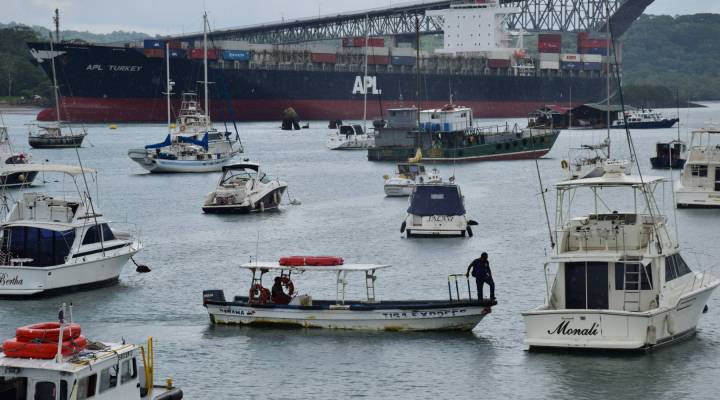
What happens when shipping lines build for growth that never comes
What happens when shipping lines build for growth that never comes

This Sunday, that superhighway of global commerce, the Panama Canal, now widened for much bigger ships will open for business. The opening of the canal is a moment of crowning glory for Panama, but not a moment of crowning glory for globalization. The opening of the new canal lanes comes at a time where world trade has come off the boil, which is the theme of our coverage this week. Today, what’s with the cargo shipping business?
It was the American trucking-turned-shipping tycoon Malcolm McLean who invented standardized shipping containers 60 years ago. The 20-foot long metal boxes are easy on, easy off between trucks, ships and railcars. To U.S. workers who saw their factories go overseas, these containers are weapons of mass job destruction. But to many economists, these shipping containers reduced the friction of global trade so that countries could stick to doing and making what they were especially good at, thereby fueling economic growth. Too bad the companies that ship cargo are not seeing that growth these days.
“Container shipping has proven to be a very, very treacherous business,” said Marc Levinson, an economist, historian and author of “The Box: How the Shipping Container Made the World Smaller and the World Economy Bigger. “
“Ship lines have to make very expensive investments and they have to plan them pretty far in advance. The world economy at the time these ships are actually built and ready for service may be quite different from what they thought it was going to be when their vessels were ordered,” he said.
Containers sit in the Port of Balboa, east of the Pacific entrance to the Panama Canal.
That happened. These are tough times for shipping companies — the names you see on containers after they are lifted from ships and clamped onto the back of trucks. Maersk, Hapag-Lloyd and others ordered lots of newer and bigger ships.
“In the first half century after World War II, international trade grew at about 7 percent a year. It was really a booming business. More recently, we’ve seen trade grow at about the growth rate of the world economy, three or four percent,” Levinson said. “All these vessels that had been ordered based on the expectation that trade was going to boom are providing excess capacity right now. That’s made for hard times for many ship lines.”
“The rate collapse, that’s the best word for it, has been absolutely catastrophic,” said Tim Power, managing director of Drewry Shipping Consultants in London.
Power sees two pressures colliding so that shippers can’t charge what they once could: weaker trade and bigger ships.
“We are getting an increased over tonnage of vessels. This is putting a downward pressure on pricing. This is made much worse by the fact that a lot of these ships are the very big ones and the lines are thinking how are we going to deploy them and so they are fighting for market share in order to keep the volume so they can fill them,” Levinson said.

Copyright © 1998-2015, Adapted from Dr. Jean-Paul Rodrigue, Dept. of Global Studies and Geography, Hofstra University.
The new Panama Canal can take ships loaded with up to 14,000 containers, compared to about 5,000 per ship in the old canal. That actually adds capacity at a time when there’s already a glut. Couple that with the general problem for shippers: Trade around the world has turned listless.
“Trade growth is slowing down, and it’s not growing as fast as GDP anymore,” said Aaditya Mattoo, research manager of trade and international integration at the World Bank.
China’s favoring of its consumers over exports is part of this. Europe’s economy, juddering along on missing cylinders, isn’t helping. Many of the countries that could integrate into the world trading system have already done so. All of this leads some experts to use the term “peak trade.”
Looking north through a fence on Isla Flamenco, toward Panama City.
“I would hesitate to say peak trade; let’s say a temporary plateau of trade,” Mattoo said. “There’s huge scope for further growth in trade if we draw in more products, not just goods but services. And not just the usual participants which are the United States, parts of Europe and Southeast Asia, but draw in Africa, South Asia, South America.”
But what if the opening of the Panama Canal isn’t happening during a temporary plateau for trade, but rather comes at the end of an era? To use an analogy from the stock market: What if globalization is no longer an impressive growth stock, but has become like a utility stock — a steady earner without much of an upside? Tomorrow, we’ll talk to a Nobel economist about why that matters. Find all of our upcoming coverage here.
There’s a lot happening in the world. Through it all, Marketplace is here for you.
You rely on Marketplace to break down the world’s events and tell you how it affects you in a fact-based, approachable way. We rely on your financial support to keep making that possible.
Your donation today powers the independent journalism that you rely on. For just $5/month, you can help sustain Marketplace so we can keep reporting on the things that matter to you.












